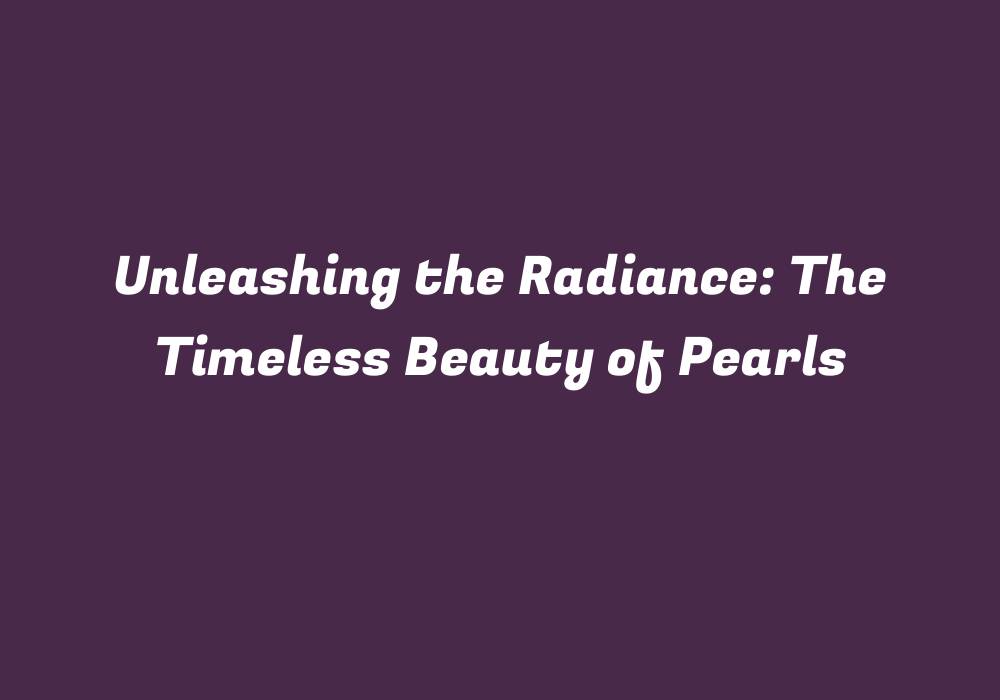Introduction
Throughout history, pearls have been a symbol of elegance and sophistication. With their natural luster and timeless beauty, they represent the epitome of grace. This article will explore the radiance of pearls, examining the various types, the science behind their formation, and how they have captivated hearts across generations.
Types of Pearls
Pearls are primarily divided into two main categories: natural and cultured. Natural pearls form in oysters or mollusks when a foreign object, such as a grain of sand or an irritant, is introduced into their shell. The process of creating a natural pearl takes years and is not guaranteed to succeed, which makes them extremely rare and valuable.
Cultured pearls are created using the same process as natural ones, with the addition of human intervention to stimulate the growth of pearls. Pearl farmers introduce a bead or nucleus into an oyster or mollusk and provide care throughout the process. This technique allows for the controlled production of beautiful pearls, making them more accessible and affordable.
A third type, known as Keshi pearls, are formed accidentally while cultivating other pearls, with no bead or nucleus intentionally introduced into the oyster or mollusk. They can come in various shapes, sizes, and colors, making them unique and sought after by collectors.
The Science Behind Pearl Formation
Pearls are formed when an irritant enters a mollusk’s shell, stimulating the production of nacre (a substance composed of aragonite and conchiolin) to encapsulate the foreign object. Over time, layer upon layer of this lustrous material is deposited around the irritant, eventually forming the pearl. This process requires both patience and specific environmental conditions. The mollusk must be able to survive while producing nacre at a consistent rate for an extended period.
Natural pearls are formed when oysters or mollusks find an irritant in their environment that stimulates the nacre production process. Conversely, cultured pearls rely on human intervention to initiate the pearl-forming mechanism by introducing a nucleus and bead into the mollusk’s shell.
The Role of Color and Luster in Pearls
Pearl color can range from creamy white to deep black, with shades of pink, purple, green, and blue also being found. The most valuable pearls are generally white or off-white, as these colors work well with a wide array of clothing styles and accessories. Other pigments may come from the mollusk’s diet or the surrounding environment.
Luster refers to the way light reflects and refracts within a pearl, adding depth and vibrancy to its appearance. The highest quality pearls have high luster and reflect light like glass, creating an almost magical effect that is unique to each gemstone.
While color and luster are essential factors when evaluating the value of a pearl, the overall beauty of a pearl lies in the combination of these elements. A well-rounded pearl should have a blend of attractive colors and exceptional luster, which contributes to its lasting appeal and enduring charm.
The History and Significance of Pearls
Pearls have been associated with beauty, wisdom, and purity for centuries. They have been used as adornments and symbols of wealth throughout history by various cultures around the world, including ancient Egyptians, Greeks, Romans, and Chinese. In recent years, pearls have continued to captivate audiences due to their unique combination of elegance and versatility.
Today, pearls are used in a wide range of settings, from fashion statements and jewelry designs to luxury timepieces and home decor. They also serve as an investment opportunity for those looking to acquire beautiful and enduring treasures that maintain their value over time.
Conclusion
The radiance of pearls has captivated hearts across generations, transcending cultural boundaries and remaining a symbol of sophistication and elegance. From the natural splendor of rare gems to the controlled beauty of cultured treasures, pearls continue to fascinate with their timeless allure. Whether prized for their rarity or celebrated for their versatility, these exquisite gems remind us that there is an undeniable charm in the perfection of imperfection found within nature’s masterpieces.
Sources
Pearl – Britannica Encyclopedia
Natural, Cultured, and Fake Pearls – Gemological Institute of America
Types of Pearl: Natural, Cultured & Keshi Pearls – The Spruce Crafts
Color Variation and Pearl Value – Pearl Guide
The History of Pearls: How These Precious Gems Became a Symbol of Luxury – National Geographic
